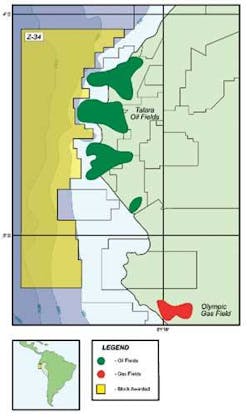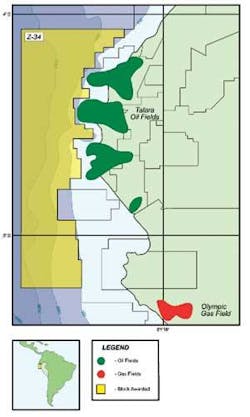Seabed logging technique to pry open Peru’s deepwater locker
Peru’s prolific Talara basin has generated over 1.7 Bbbl of oil and associated gas from onshore fields, some of which have proven seaward extensions. No wells have been drilled, however, in adjoining waters beyond a depth of 100 m, and seismic data beyond this point is sparse.
For various reasons, the industry has ignored the deeper water plays as being high risk, but this is also the attraction for Plectrum Petroleum. The Aberdeen-based company - which focuses exclusively on under-explored frontier provinces - is currently finalizing terms with Perupetro for a 30-year license for the Talara basin offshore block Z-34.
The 3,713 sq km block extends from water depths of 100 m out to 3,000 m. Assuming sanction early next year from Peru’s Ministry of Energy and Mines, the license will be split between AIM-listed Gold Oil, as operator, and Plectrum, as approved contractor. Gold is already drilling elsewhere onshore Peru.
Plectrum was formed two years ago by Chairman Mike Whyatt and COO Mike Evans. Like numerous other start-up oil and gas companies, Plectrum raised funds initially via the UK’s Alternative Investment Market (AIM) in 2005. “We had been screening opportunities for exploration since 2004,” says Toby Lenehan, head of exploration.
Following successful flotation the following year, Plectrum’s initial main cash influx came via a reverse takeover of Table Mountain Minerals, another new company formed with the idea of pursuing mineral exploration onshore South Africa. Whyatt and Evans, however, persuaded the directors to divert their funds instead into Plectrum.
Today the company is capitalized at £25 million, allowing it to compete for promising or neglected deepwater acreage worldwide. Over the past few months, it has also secured operatorship of two permits in the Bremer sub-basin, off southwest Australia, and another in the Gulf of Hammamet, offshore Tunisia, close to the Tazerka oil field formerly produced by Shell.
“It is unusual,” Lenehan says, “for a start-up company to focus on deepwater frontier exploration. The problem with this approach is the level of risk - you can end up with a lot of non-commercial discoveries, or find yourself weighed down by large development costs if you do discover something.
“One way of closing the gap, we believe, is to de-risk the costs of exploration drilling by combining conventional seismic data gathering with innovative imaging techniques, notably controlled source electro-magnetic imaging (CSEM). In our case, we have formed a strategic alliance with one of the main specialist providers of this technology, Offshore Hydrocarbon Mapping (OHM) in the UK.”
CSEM, also known as seabed logging, employs electro-magnetic remote-sensing devices to detect the presence and extent of hydrocarbons below the sea surface. The survey method involves a boat towing a dipole source just above the sea floor to transmit a low frequency electromagnetic field into the subsurface. This field becomes modified as it encounters resistive layers, these changes being detected and logged by a 2D array of receivers on the sea bed.
Resultant data are processed to provide spatial information concerning the resistivity structure of the subsurface. Since hydrocarbon-bearing formations are normally highly resistive compared with surrounding formations, CSEM can indicate the presence of oil and gas. It can also detect and map the edges of any accumulations with a higher degree of accuracy than traditional technologies such as seismic, thereby lessening the risk of selecting locations for exploration wells.
According to Lenehan, over 150 surveys have been completed worldwide using CSEM. The technique works better in deepwater (penetrating the subsurface to one and a half times the water depth), and is favored by several major operators. ExxonMobil, for instance, has had good results applying the technique in ultra deepwater offshore Angola.
Seismic coverage
The existing datasets over block Z-34 are derived largely from 500 km of 2D seismic acquired during the 1970s and ‘80s. This comprises 37 seismic lines, of which only eight extend across the whole block, with spacing in between of 20 km - insufficient to properly define prospectivity.
Once the new program gets under way, the partners plan to hire a seismic vessel - probably under a time-sharing arrangement with other consortia in the area - to acquire a new 2D grid across the entire block, with 6-8-km long offsets. The results would be integrated with the existing geological data, followed by a CSEM survey and marine magnetotelluric studies to de-risk the best prospects.
Recent analysis suggests there is potential for productive deepwater turbidite reservoirs in the central and western parts of the block, with the source rock for oil being at least of Tertiary age. This could be the continuation of a trend seen in the prospective Tumbes basin to the north. “It’s encouraging for us,” Lenehan says, “as that area is already under exploration.”
“The state oil company Perupetro is very transparent in its dealings,” Lenehan says, “and is very clear about how licenses will be awarded. Peru’s tax situation is also very competitive, with a basic rate of 30%, and royalties negotiable between licensees and the state.”
Plectrum’s technical/interpretation studies will be performed mainly at its headquarters in Banchory, eastern Scotland, with some work subcontracted to consultants. But a branch office will also be opened in Lima. “It’s desirable to put as much inward investment into the country as possible,” says Lenehan. “We may move some G&G work there as the project progresses.”
“Another issue we will have to address is the remoteness of this area from established oilfield service bases and infrastructure. This may entail our using nearby ports for exploration support services.”
Block Z-34 was originally licensed to Gold as a two-year prospecting permit, with the option to convert at the end of this term to a 30-year exploration and exploitation permit.
Jeremy Beckman, Editor, Europe

